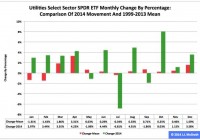Can Pharma ETFs Continue Their Uptrend In 2015?
The pharmaceutical sector, which had been witnessing several tax inversion deals over the last few months, is not likely to go down this route given the Sep 2014 notice issued by the U.S. Department of the Treasury. New rules imposed by the Treasury Department make such cross-border deals unattractive — in fact, companies like AbbVie (NYSE: ABBV ), Auxilium (NASDAQ: AUXL ) and Salix (NASDAQ: SLXP ) backed off from such agreements. However, mergers and acquisitions (M&As) will continue to play a major role and are not showing any signs of slowing down. Auxilium, which terminated its merger agreement with QLT (NASDAQ: QLTI ), will be acquired by Endo in the first quarter of 2015. Other acquisition deals announced recently include the upcoming acquisition of Cubist (NASDAQ: CBST ) by Merck (NYSE: MRK ) and that of Avanir (NASDAQ: AVNR ) by Japanese firm, Otsuka ( OTC:OSUKF ). Meanwhile, small bolt-on acquisitions will continue. In-licensing activities and collaborations for the development of pipeline candidates have also increased significantly. Therapeutic areas attracting a lot of interest include oncology, central nervous system disorders, diabetes and immunology/inflammation. The hepatitis C virus (HCV) market is also attracting a lot of attention. Immuno-oncology has been a key focus area this year as these therapies have the potential to change the treatment paradigm for cancer. Restructuring activities are also gaining momentum as large pharma companies are looking to cut costs and streamline their operations. Most of these companies are re-evaluating their pipelines and discontinuing programs which do not have a favorable risk-benefit profile. Another recent trend is the divestment/monetization of non-core assets so that the companies may focus on their core areas of expertise. Biosimilars and emerging markets are also a focus area. New Products Gaining Traction New products are steadily gaining traction and contributing significantly to sales. Drugs like Tecfidera (multiple sclerosis), Sovaldi (HCV), Olysio (HCV) and Imbruvica (cancer) are off to a strong start and represent significant commercial potential. So far in 2014, important product approvals include Esbriet and Ofev (idiopathic pulmonary fibrosis), Harvoni (HCV), Plegridy (multiple sclerosis), Keytruda (melanoma), Otezla (active psoriatic arthritis) and Dalvance and Sivextro (skin infections). Pharma ETFs in Focus Highlighted below are some pharma ETFs – ETFs present a low-cost and convenient way to get a diversified exposure to the sector. Powershares Dynamic Pharmaceuticals ETF ( PJP ) PJP, launched in Jun 2005 by Invesco PowerShares, tracks the Dynamic Pharmaceuticals Intellidex Index. The fund covers only health care stocks. The top 3 holdings include Eli Lilly (NYSE: LLY ) (5.22%), Gilead (NASDAQ: GILD ) (5.19%) and Celgene (NASDAQ: CELG ) (5.14%). The total assets of the fund as of Dec 9, 2014 were $1,511.7 million representing 27 holdings. The fund’s expense ratio is 0.58% while dividend yield is 0.42%. The trading volume is roughly 140,267 shares per day. SPDR S&P Pharmaceuticals ETF ( XPH ) XPH, launched in Jun 2006, tracks the S&P Pharmaceuticals Select Industry Index. This ETF covers pharma stocks with the top 3 holdings being Avanir Pharmaceuticals (5.09%), Auxilium Pharmaceuticals (4.52%) and Impax Laboratories (NASDAQ: IPXL ) (4.04%). Total assets as of Dec 9, 2014 were $1,114.72 million representing 35 holdings. The fund’s expense ratio is 0.35% and dividend yield is 0.57%. The trading volume is roughly 48,791 shares per day. iShares U.S. Pharmaceuticals ( IHE ) IHE, launched in May 2006, seeks investment results that correspond generally to the price and yield performance of the Dow Jones U.S. Select Pharmaceuticals Index. The fund mainly consists of pharma companies (88.38%). Biotech companies account for about 11.53% of the fund. The top 3 holdings of this fund are large-cap pharma companies are Johnson & Johnson (NYSE: JNJ ) (9.22%), Pfizer (NYSE: PFE ) (8.12%) and Merck 7.21%). The total assets of the fund as of Dec 9, 2014 were $850.8 million representing 43 holdings. The fund’s expense ratio is 0.43% with the dividend yield being 1.15%. The trading volume is roughly 30,863 shares per day. Market Vectors Pharmaceutical ( PPH ) PPH was launched in Dec 2011 and tracks the Market Vectors U.S. Listed Pharmaceutical 25 Index. The top 3 holdings of this fund are large-cap pharma companies – Johnson & Johnson (10.73%), Novartis (NYSE: NVS ) (9.73%) and Pfizer (7.64%). The total assets as of Dec 10, 2014 were $354.8 million representing 26 holdings. While the expense ratio is 0.35%, dividend yield is 1.54%. The trading volume is roughly 166,369 shares per day. Conclusion The worst of the patent cliff is over for the pharma sector which is slowly but steadily recovering from the impact of genericization. The NYSE ARCA Pharmaceutical Index is up 19.3% over the last year. Many companies, which had been struggling to post growth in the face of genericization over the past few years, are now on the recovery path. New products should start contributing significantly to results, and increased pipeline visibility and appropriate utilization of cash should increase confidence in the sector.
